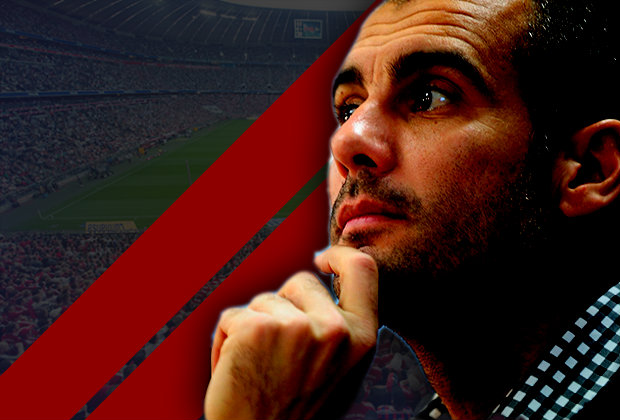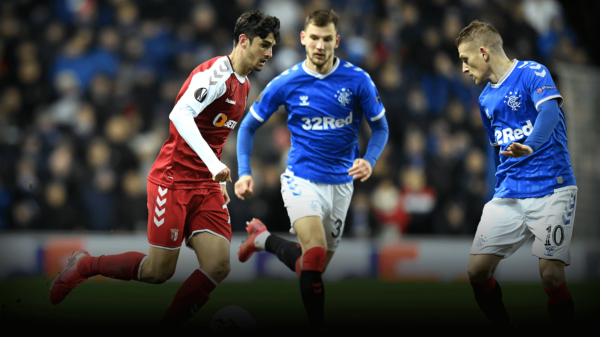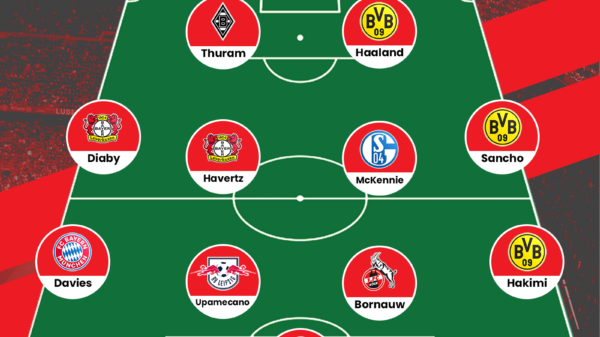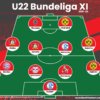Throughout his coaching career, Pep Guardiola has always implemented his knowledge of positional sense gained as a player to extract, innovate and develop tactics that resulted in his team having positional superiority against the opponents. While many have tried and failed, Guardiola has been immensely successful in this aspect. Hamoudi Fayad documents the tactical spectacle that Guardiola directed via a star studded Bayern Munich side.

If you haven’t read Adin Osmanbasic’s tactical theory on Juego De Posicion under Pep Guardiola, then do so before reading this article.
Pep Guardiola is arguably the greatest manager in World Football right now. Having managed the likes of FC Barcelona and Bayern Munich, it looks as if Guardiola has had an “easy” career. “He was an icon at Barcelona and they wanted someone from inside the club to manage, and because he had such an amazing team plus Messi, he won everything and then Bayern got him. It was easy for him. He didn’t go through tough times at Ajax or Porto like Van Gaal and Mourinho did.” This paragraph – and many other variations of it – has been repeated countless times by thousands of different football fans. Although why do I, and many others, think that Guardiola has revolutionised the state of football – tactically and psychologically – in the past few years? Simply because Guardiola has risen up to the grandest stage of them all on many different occasions through his annihilating tactical innovation: not tiquitaca, but Juego De Posicion.
UPDATE: This article featured in Goalden Times’ Word Ball 2015 in the Analytical category.
The modern football fan may not realise it, but the real tactical innovation of Pep Guardiola was Juego De Posicion. Tiquitaca was just a name for “passing for the sake of it” as Pep Guardiola put it in Marti Pernarau’s recent book Pep Confidential, where Pep explains his tactical ideologies and methodologies. There are many different factors that shape up Guardiola’s philosophy, with the main emphasis being placed on positional play. Returning to the tiquitaca theory; Guardiola claimed that if there weren’t a sequence of 15 passes first, then it “would be impossible to carry out transition from defence to attack. Impossible.” Guardiola backs himself up with reasons, seamlessly continuing his thoughts on tiquitaca:
“It’s not the possession or one-touch passing that matters, but the intention behind it (Disorganising the opposition). How do you disorganise them? With fast, tight, focused passing as part of this 15-move sequence. Although some of your players will need to maintain a bit of distance from each other to stretch out the rival team. Use 15 passes to make sure that your team is well positioned and close together at the point where a move might break down, so that it’s easier to press and win the ball back swiftly.” -Pep Guardiola
The modern day innovation of counter pressing becomes much easier because Guardiola’s teams pass in shorter and tighter distances, and if you couple that up with the fact that the ball holder is supported by a minimum of 2 or 3 players around him – then superiority in specific zones during the game will be accomplished, and if the ball is lost due to an error; it can be easily won back.
One more tactical theory that Pep Guardiola has mastered over the last 2 years is the use of the free man. Arjen Robben, Franck Ribery and Mario Gotze are some of the best examples of this. This “free man” is either found on the underloaded side of the pitch (the farthest diagonal point away from the ball) or drifting freely in between the lines, aiming to break through the enemy lines. Robben is a key example of staying on the underloaded side of the pitch: Alaba, Lahm and Alonso could be working passes through the left flank of the pitch before immediately hitting a diagonal ball to the right flank – where Robben is free to pounce on, cut inside and shoot.

Formations and numbers don’t matter anymore, which is why I have concluded that – at times of Guardiola’s ‘attack’ mentality – Bayern Munich do revert into a near 2-3-5 system while attacking (which they do for most of the game) regardless of their ‘starting formation’ being a 4-1-4-1 or 3-4-2-1. Guardiola normally chooses between two types of ways to approach upcoming matches: through “control” or “attack”. The former aims at ball retention and staying on the safe side, while the latter is a call for getting goals, goals and more goals. Chapter One began in Munich, April 8, 2014.
Chapter One: Munich | April 8th, 2014 |
“We’re going to use a 2-3-3-2”, muttered the football-obsessed coach Pep Guardiola to his surprised, yet encouraged, set of players who were prepared for their 2nd quarter final leg against Manchester United. The formation before the game was regarded as an attacking variant of Bayern’s orthodox 4-1-4-1, with the full backs Lahm and Alaba possibly pushing up directly next to Kroos rather than attacking towards the byline. Although that was not the case in this match, as Lahm and Alaba were directly involved in the build up of play in the centre for most of the game, effectively joining Kroos as a pair of central midfielders (ignore the percentages, they’re incorrect):
A couple of weeks before the game against Manchester United, Bayern faced Hoffenheim with Rafinha and Contento as their full backs:
You can see the difference between both full backs and how they were clearly instructed to play: the amount of on-ball actions made by Alaba and Lahm were scarce compared to how Rafinha and Contento were instructed to play. The former picture shows an inverted wing back (which shows how Alaba and Lahm played, although with even more attacking freedom) and the latter shows an orthodox full back hugging the touchline.
This was Bayern’s build up through the back: Kroos dropping in between the two centre backs and able to play third line passes to Lahm and Alaba who dropped in as a double pivot while Kroos formed a back 3. Lahm and Alaba would drop in to defend in their natural full back positions once Manchester United attacked (rarely), although their attacking movement signified their traits and behaviour as inverted full backs.
As the play builds on, Kroos pushes up in between the “false” double pivot of Lahm and Alaba and successfully circulates the ball while dribbling into space due to Manchester United’s passive style of play; sitting in two banks of four and aiming to play out to Valencia who then joins Rooney and Welbeck.
The 4 circles + the arrow are the five attackers placing themselves in their shape. Robben and Ribery on the outside of the full backs, while Mandzukic and Muller roaming near the channels and Gotze sneaking in between the lines.
Here is one moment that will be emphasised later on in this article, as Robben cuts inside as usual while Lahm strays to the outside of the winger to avoid clashes in between lanes. The dotted black lines show Lahm’s movement off the ball, while the green line shows Robben’s movement on the ball. Alaba and Muller (squared in black) look for space to exploit that Manchester United left exposed. The constant movement, intensity and positional play that Bayern have mastered and grown into during the second half of 2013-14 and the first half of 2014-15 have been a joy for the neutrals to watch.
Chapter Two: Rome | October 21st, 2014 |
The innovation of an inverted wing back needs to coincide with the winger’s movement, and since Robben and Ribery stray wide as the free man before cutting inside once they get the ball the full back needs to be in either a different vertical or horizontal lane. Here are examples of the wingers and the full back’s rhythmic movements:
Robben passes it Lahm, and makes a run in behind the defender into the channel.
A wall pass is made as Lahm gives it back to Robben, and we can see a clear 8-v-5 overload in favour for Roma. 2 defenders are occupying Robben while the red box shows how Muller is occupying 2 defenders.
As Robben cuts inside, we can see Lahm at the edge of the box for support and the ability to counter press. The shapes are a bit confusing, but let me clarify their significance. This overload in favour of Roma is huge, although Bayern easily end up scoring in the space of a few seconds. How?
Muller (in the green circle) draws a defender out with his constant investigation for space while Lewandowski and Gotze both occupy 2 defenders each (in the purple and blue squares). This ceaseless, and organised, movement is what makes Bayern so dangerous. Robben has his chance to score and, if he doesn’t (he did), Lahm and Muller are able to counter press with the support of Alaba from behind. You also have to credit Robben’s finishing, a non-tactical factor in the game of football which people fail to realise.
These opportunities are made due to the amount of time Bayern are allowed in their opposition half, which is caused due to the average distance from the defensive line to the goal being 43.5 meters. Pep Guardiola is always adamant on playing inside the opposition’s half.
This is how high Bayern’s defensive line sits – around the halfway line – with Alonso doing his job in picking the ball up out of the defence (as Kroos did the year before) and distributing it across the field.
The Free Man Theory, why it’s so important and how to exploit it
There is no designated free man in Bayern’s squad. It can be Robben or Ribery being placed at the farthest diagonal point away from the ball, or it can be Gotze breaking through the lines, or Muller looking for space as usual… Alaba or Lahm could even be the free men in such situations, by straying near the edge of the box or continuously switching with one of the attacking players.
The key for Guardiola’s philosophy on the free man is how to stop the free man being used against him. There is no point of using Gotze as a free man in a key game, if Guardiola can’t exploit the weaknesses of the opposition’s free man. The free man could be a counter attacking threat, a long shot threat, a passing threat, or even a player who can shield the ball for his team to get the sufficient amount of players into their attacking positions. These types of players and teams are studied and analysed heavily by Pep Guardiola, his head of Opposition Analysis Carles Planchart and his team of analysts.
15 tight, concise and swift passes are vital to the system because all of these factors connect together. Playing in the opposition’s half minimises the opposition’s chance of controlling the match (although makes Bayern more vulnerable to counter attacks), while the 15 pass build-up enables them to be in control of the situation, being able to exploit the game better as the opponent will be out of shape, while the main objective of keeping the ball will prevent the opponent from finding space and using their free man.
“For a team which wants to dominate the ball and be the game’s protagonist, managing the free or open opponent is the principal defensive objective.” -Pep Guardiola
A final look at the average positioning of Bayern during their phases of “attack”:
Against Manchester United: the line of defence consisted of Dante and Boateng while Alaba, Kroos and Lahm represented the midfield. Alaba looks more like a left wing back in the photo due to him returning to a left back position towards the end of the game, while Rafinha went on at right back. Mandzukic and Gotze dropped deeper and made the defensive formation a more 2-3-2-3, although in the attacking phase Gotze and Mandzukic were in the front line; Guardiola allowing Gotze to “join the attack as an anarchic striker” as per Marti Perarnau.
The “real” 2-3-5 was shown in full flesh here against Roma (7-1), with Boateng and Benatia protecting the goal forming the possible best back two in the world. Lahm, Alaba and Alonso formed the 3 while Bernat added attacking verve towards the touchline (showcasing his technical skill with a brilliant cross to Lewandowski for the 3rd goal). Lewandowski, Muller and Gotze continuously roamed around while Robben left a big gap, as he was the free man in this game. Robben would wait for the ball without having any defensive responsibilities:
“The players have to adapt to a positional attacking. For example, I’m a fan of wingers and I’ve got two magnificent examples of that breed. But in order for them to have an advantage when they get on the ball we have to build right from the back so that they have an advantage over the rival from the instant they receive the ball. It requires patience.” –Pep Guardiola
That is the beauty of Juego De Posicion; it does not only consist of one main innovation, but it consists of many different variables that take time to be perfected. Saying that, it would have been amazing to watch Bayern of this season play the Atletico of last season – who were the best in the world at controlling space and giving the opposition possession of the ball.
Written by Hamoudi Fayad
- Hipster Guide 2016-17: Bayer Leverkusen’s tactics, key players and emerging talents - August 25, 2016
- Talent Radar: Saudi Pro League 10 Young Players (U-23) to Watch in 2016-17 - August 23, 2016
- Dry Grassroots: Youth Football Deficiencies in Western Asia - July 19, 2016






































































